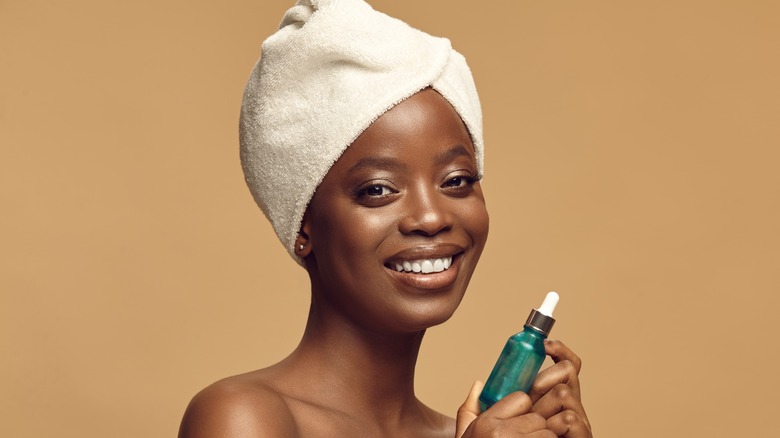What's The Deal With The Retinol Sandwiching Skincare Trend?
We may receive a commission on purchases made from links.
Retinol has remained one of the buzziest skincare ingredients in recent times, and for good reason. A derivative of vitamin A, retinol is a skincare ingredient with a wide range of benefits, the most popular being its anti-aging properties. Other benefits include improving skin texture by increasing the cell turnover rate, increasing collagen production within the skin, and treating hyperpigmentation (per The Skin Spot).
Retinol is available in over-the-counter treatments and serums and, according to Dermstore, it's less potent than prescription retinoids and other vitamin A derivatives. This lower potency makes retinol a great way to get into retinoid skincare with fewer side effects (per Healthline). However, even at the lowest strength, retinol can still be difficult for the skin to get used to, especially for beginners. This problem birthed the retinol sandwich — it's like the moisture sandwich, which involves layering hydrating products to trap lots of moisture in your skin — but with a slight twist.
The retinol sandwich: how does it work?
It's not a real sandwich, but let's think of it that way. The theory behind the retinol sandwich is that applying a layer of moisturizer before retinol slows down its penetration or absorption into the skin. This diminishes the risk of irritation, dermatologist Dr. Michelle Henry explained to Kiehl's. Retinol is also able to penetrate the skin's deep layers. This is why skin experts advise against applying it on damp skin where absorption is easiest and deepest. As Skincare.com recommends, you can start by applying a lightweight moisturizer to clean, damp skin. Afterward, follow it up with your retinol serum or lotion when the moisturizer is fully absorbed.
After applying the retinol product, apply another layer of moisturizer on top to complete the retinol sandwich. If you need more moisture, Sublime Life confirms that you can apply a thicker moisturizer as your top layer after applying the retinol product. Again, think of this method as your childhood-favorite peanut butter and jelly sandwich, except your bread is a moisturizer, and your retinol is the PB&J.
What to know about retinol sandwiching
Like many other hacks and techniques, the retinol sandwich is great for some skin types, but can be wasteful or ineffective for others. If you have sensitive skin or a history of skin irritation due to a new skincare product in your rotation, the retinol sandwiching method reduces the chance of redness or flakiness. For people who do not have sensitive or easy-to-irritate skin, applying moisturizer first will most likely lessen the retinol's absorption into the skin, reducing its effectiveness (per Skin Inc).
If you're new to retinol, be sure to apply only a pea-sized amount and avoid your eyes, nose, and mouth, as they are more prone to irritation and flakiness (per goPure Beauty). Sachi Skin also says you can track your skin's tolerance to the retinol product by using it once a week and only at night to avoid sun exposure. Lastly, not everyone can use retinol, even with the sandwich method. For people who are allergic to retinol or have hypersensitive skin, the Cleveland Clinic says it's best to skip this wonder product and go for other anti-aging skincare ingredients.


